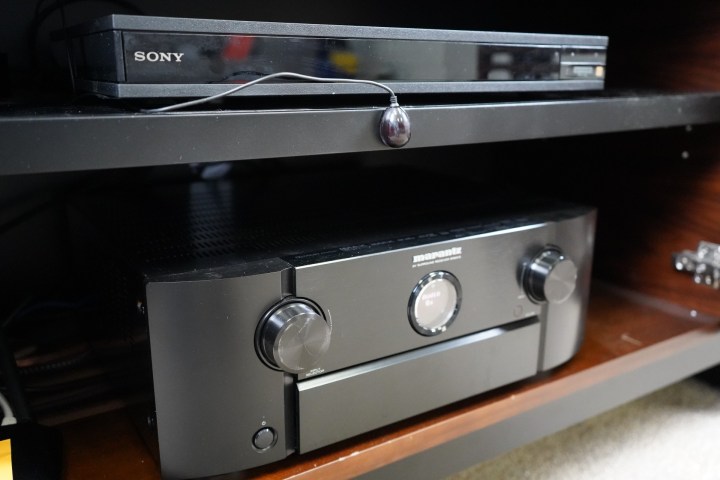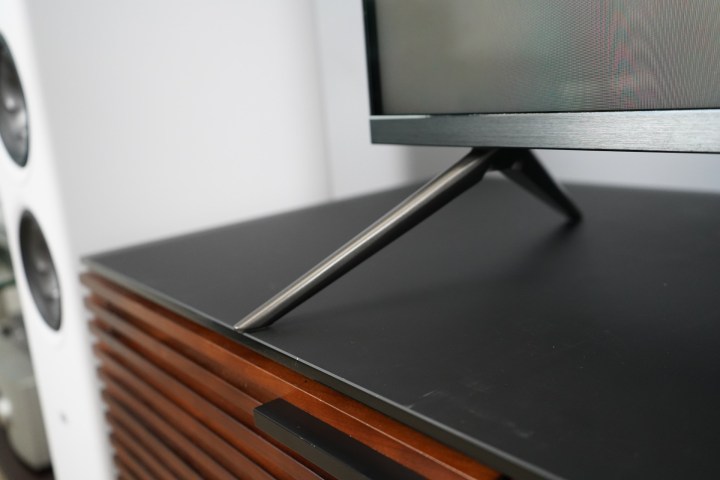
“A solid mid-tier TV with the best Fire TV experience yet.”
- Excellent Fire TV experience
- Great smart home hub
- Adequate picture performance
- Fun features
- Lacks HDR punch
- Price-to-picture performance ratio is off
One year after the first Amazon TVs were released comes the Amazon Fire TV Omni QLED TV. New for this year are quantum dots for better color, full array local dimming backlight control for better contrast, and an optical room sensor that enables a few clever tricks, including an “Ambient Experience” and an auto-off/on feature.
More features? Yes. More money? A little. More Performance? Yes, but don’t get too excited just yet. Let’s figure out if the new Amazon Fire TV Omni QLED might be the right TV choice for you.
Video review
Series and size details
| Screen Size | Model Number | MSRP |
| 65-inch | QL65F601A | |
| 75-inch | QL75F601A |
Effortless navigation
If you’re not familiar with Amazon’s branded line of TVs already, just imagine the Amazon Fire TV interface you find in its streaming sticks and the Fire TV cube, but baked right into a TV — similar to how we see Roku TV and Google TV baked into TCL and Hisense TVs. Amazon has had Fire TV baked into sets before, too. But Omni is a little different. It’s Amazon through and through, complete with the Smile logo.
Amazon’s voice assistant is really at the heart of the Omni QLED.
One of the best things about the Fire TV Omni QLED is that it runs Fire TV OS effortlessly. There’s virtually no lag between clicking a button on the remote and the corresponding action on the TV. I like a smart TV interface that moves as quickly as I can click a remote, and the Fire TV Omni QLED absolutely does that. Apps load quickly, too. And as voice assistants go, Amazon’s Alexa can only be matched by the
In fact, Amazon’s voice assistant really is at the heart of the Omni QLED and its appeal. Anything you can do with an Amazon Echo speaker, you can do with this TV, sure. But the functionality keeps going from there. For instance: You can control other devices with the TV using voice control because it includes IR blaster, and it utilizes HDMI CEC effectively. Just place the IR blaster in sight of your other home entertainment equipment and you can control an A/V receiver, cable box, Blu-ray player, you name it — a lot like the new Fire TV cube, actually.
Also central to the Fire TV OS experience is the manner in which it is designed to house all of your content, be it broadcast TV, cable or satellite TV, paid and free streaming TV — all of it — all in one place. Amazon puts everything you want on its home screen and tries to make it as easy as possible to get to what you want to watch.
Whole-home hub
Now think of Amazon’s ecosystem outside of home entertainment. Your Ring security cameras, for instance, are instantly visible on a Fire TV device. (Ring is, of course, owned by Amazon.) Want to control your smart home thermostat? (Amazon owns one of those, too.) Just grab your remote. Or don’t, you can have the TV always listen for you to give the command if you’re comfortable with that. If you aren’t, though, a switch on the TV disables the built-in microphone.
It’s designed to be a powerful smart home hub, not just an entertainment hub.
And if you add a webcam, you can use the TV for video calls. You get the idea. It’s designed to be a powerful smart home hub, not just an entertainment hub.
Art mode
One notable new addition this year is the ambient mode (which Amazon calls Ambient Experience) and the automatic on/off features I mentioned earlier. There also are widgets available in the art mode as well. You can have daily reminders, calendar entries, sticky notes, weather updates, or news headlines pinned to the bottom of the art mode screen for at-a-glance information. I think this ambient mode probably will play well with customers, though it’s really just a screensaver until you factor in the widgets, which are handy to have. The Fire TV Omni QLED doesn’t pull off art mode as convincingly as, say, Samsung’s The Frame TV.
Frankly, it’s the auto-off/on feature that integrates with the art mode that I like best. This is probably the best use of a room sensor I’ve seen yet and one that will cut down on wasted electricity use. The TV will shut down the screen and sit in power-saving mode when it detects nobody is in the room (and/or when the lights have been turned off, if you choose that option), and then pop back into art mode when someone walks into view.
Of course, that sensor isn’t just for figuring out whether the room is occupied or vacant, it’s also what allows Amazon to slap the
Picture Quality
For anyone who follows TVs a bit, you may be interested to know that I’m pretty sure the Amazon Fire TV Omni QLED basically is a TCL 5-Series running Amazon Fire TV OS. It looks like the 5-Series, with a voice-recognition and IR receiver block down below the metal strip bezel along the bottom edge, TCL-style feet, and even the stamped metal backing. But it’s really the measurements that have me convinced this is equivalent to the 2021 TCL 5-Series, which also is an
Brightness
Peak brightness numbers of around 575 nits is a hard sell at this price.
Using Calman Ultimate software, a Murideo Seven G pattern generator, and a C6 Colorimeter profiled to an i1 Pro 2 Spectro, I measured peak brightness in SDR and

While I’m fairly impressed with the local dimming and relatively decent black levels and blooming control that comes with it on this TV, a peak brightness number of around 575 nits is a hard sell at this price. To put things in perspective, the Hisense U7H we recently tested — which retails for the same price as the Omni QLED here — puts out right around 1,000 nits peak, which is substantially brighter. And when we talk about brightness, I’m not just talking about the ability to look good in a bright room — high peak brightness is really important for making
Color
When it comes to color performance, I measured some fairly significant errors in terms of accuracy. Again, if this TV cost about the same as the TCL 5-Series — there’s a $250 difference at the 65-inch size and $300 at 75 inches — I’d go a bit easier on it for not having very good color accuracy. Don’t misconstrue these accuracy claims to mean the TV has poor-looking color, though. I don’t think you’ll look at this TV and think, “Hey, the color looks off on this TV.” Not at all. In fact, most of the time I found the color output to be well within acceptable parameters. But, again, it’s worth noting that, for the price, the Hisense U7H is more color accurate out of the box.

Gaming
The Omni QLED isn’t as chock full of advanced gaming-friendly features as some competing models like the Hisense U7H. The Fire TV Omni QLED maxes out at
That extends to networking, too. While there’s an Ethernet port on board, no surprise there. But like the new Fire TV Cube, it’s a 10/100 connection and not the much faster Gigabit Ethernet. While that’s far from a deal-breaker, it’s disappointing because faster is better. It’s worth pointing out, though, that the TV does support Wi-Fi 6 for high-speed wireless throughput.
Sound quality
As for sound quality? Actually, this TV’s got a little thumpy kick to it! Don’t count on it for full-bodied cinematic sound, but I’ve definitely heard worse from TVs in this price range.
I’m not sure that this TV’s onboard sound will be a big consideration for buyers in the future, though, because I believe Amazon’s next move in home entertainment will be to produce its own soundbars.
In fact, I think everything about the Fire TV Omni QLED screams, ”Let’s out-
Bottom line
The Fire TV Omni QLED is something of a trojan horse, I think. It’s a decent-quality TV that puts an excellent Amazon experience front and center. If you buy this TV, it’s because you want a mid-level performance TV with the best Amazon Fire TV experience baked in, along with all the possibilities that will bring in the future.
But you know what else you could do? Buy the Hisense U7H and add a Fire TV Cube. Sure, the combo would run you about $130 more than just purchasing this TV, but it would give you all the Amazon goodness you want and combine it with the high-performance picture quality of the Hisense.
That seems like the right play to me, but if you prefer simplicity and your picture quality needs aren’t as persnickety, the Fire TV Omni QLED is sure to make you thrilled to be that much more ingrained in the Amazon entertainment ecosystem.










